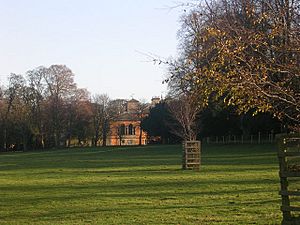Rokeby Park facts for kids
Rokeby Park is a grand country house located in the north of England. It's found in a place called Rokeby, in County Durham. This historic home sits near where two rivers, the River Tees and the River Greta, meet. It used to be part of Yorkshire a long time ago. Today, Rokeby Park is the private home of Sir Andrew Morritt. However, you can visit it on certain days to explore its history and beauty.
Contents
History of Rokeby Park
Building a Grand Home
Rokeby Park was finished in 1735. At that time, it was known as Rokeby Hall. Sir Thomas Robinson built this impressive house. It is a great example of the Palladian style. This style of architecture was inspired by ancient Roman and Greek buildings. Sir Thomas owned the house until 1769. He then sold it to J.S. Morritt. The Morritt family still owns Rokeby Park today.
Inside Rokeby Park's Design
Much of the inside of Rokeby Park was designed by John Carr. He was a famous architect. The house has many interesting things to see. You can find a collection of beautiful needlework pictures. These were made by Anne Morritt, who lived from 1726 to 1797. She was J.S. Morritt's sister. There is also a special "print room." Its walls are covered with old prints from the 1700s.
Famous Art and Visitors at Rokeby Park
The Rokeby Venus Painting
Rokeby Park is famous for a very special painting. It is called The Toilet of Venus. The artist was Diego Velázquez. This painting is now known as The Rokeby Venus. It used to hang in Rokeby Park. Today, the original painting is in the National Gallery in London. You can still see a copy of it in the saloon at Rokeby Park.
Sir Walter Scott's Poem
The famous writer Sir Walter Scott often visited Rokeby Park. He loved the house and its surroundings. In 1812, he used Rokeby Park as the setting for his long poem. The poem was simply called Rokeby. It tells a story set in this beautiful area.
External links
- Rokeby Park website
- Map sources for Rokeby Park


